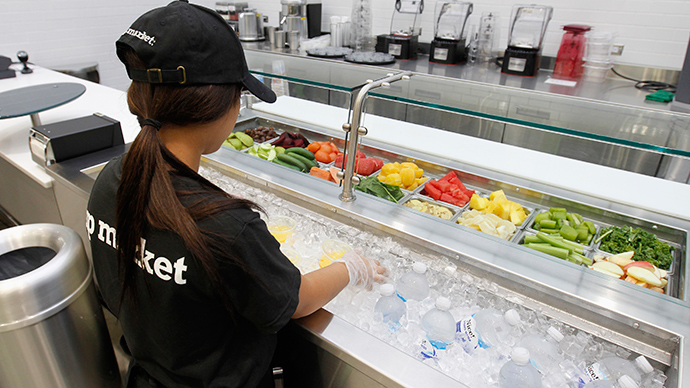As California’s multi-year drought rages on, consumers in the rest of the United States may soon be feeling the pinch at the grocery store as farmers around California reduce water and plant fewer crops.
California, sometimes called the ‘nation’s salad bowl’, is the country’s largest producer of grapes, kiwis, olives, avocados, broccoli, tomatoes, spinach, tree nuts and dairy. Now in the fourth year of a massive drought ‒ and facing only a year’s worth of water remaining in the state ‒ food prices in the US and agricultural unemployment in California are set to climb as farmers do what they can to conserve water and protect their investments.
“Farms and agriculture are prospering and they could go out of business next year,” Joe De Bosque, a farmer in California’s Central Valley, told RT. “How many businesses do you know that are prospering and profitable that go out of business? None! It’s going to happen in California, I guarantee you! If we have no water next year it’s gonna happen! Successful farms are gonna go out of business!”
De Bosque has employed new irrigation techniques in an effort to save water, as 3 million acres of land go unplanted.
“Since we've changed to drip irrigation we actually produce 30 percent more crop with 30 percent less water,” he said. “It’s not necessarily how much can we make per acre, it’s how much can we make with an acre-foot of water.”

Cannon Michael, a farmer in the Central Valley, left more than 1,000 acres of land unplanted this season to try and conserve water, he told Ensia. The fallow fields amount to about 10 percent of the 10,500 irrigated acres that make up his farm, Bowles Farming Company.
In the spring of 2014, Michael and some of his neighbors on the west side of the valley who still had some water implemented conservation measures and fallowed land early in last year’s season. Their actions allowed them to make 13,500 acre-feet (4.4 billion gallons) of water, from a reservoir known as Millerton Lake, available to east-side farmers who had been cut off. And they did so at an affordable price ‒ $250 an acre-foot ‒ rather than the $1,000 to $2,000 per acre-foot that water was trading for on the open market.
“We saw an opportunity to transfer some water to our neighbors who were struggling,” Michael said.
Yet Big Agriculture was largely spared from the mandatory water restrictions that California Governor Jerry Brown (d) issued on Wednesday, the first in the state’s history. While cities and towns are required to cut water usage by 25 percent, the agriculture industry merely has to report more information about their use of water.
But even a significant drop in residential water use will not move the consumption needle nearly as much as even a small reduction by farmers, the LA Times reported. Of all the surface water consumed in the state, roughly 80 percent is earmarked for the agricultural sector.
“The big question is agriculture, and there are difficult trade-offs that need to be made,” said Katrina Jessoe, assistant professor of agricultural and resource economics at the University of California, Davis.
READ MORE: California water restrictions should cover oil companies, activists say
Farmers aren’t the only people affected by the water restrictions.
Tractor dealer Steve Malanca is struggling because, right now, no one wants a five-year, $300,000 loan to buy a tractor, he told RT.
“All of us are being affected,” he said. “There’s an irrigation company that supplies irrigation equipment, there are tractor dealerships, there’s car dealerships selling cars to the farmers. Everybody is affected without exception... when the farmer is making money.”
Mayor Robert Silva of Mendota, in the heart of the agricultural Central Valley, told the LA Times that unemployment among farmworkers had soared as the soil turned to crust and farmers left half or more of their fields fallow. Many people are traveling 60 or 70 miles to look for work, Silva said, and families are increasingly relying on food donations.
“You can’t pay the bills with free food,” he said. “Give me some water, and I know I can go to work, that’s the bottom line.”
Some people suggest that farmers switch from animal agriculture to crops.
“Animal agriculture uses more water for drinking and growing food for feed than even the thirstiest vegetable crops. California would realize gargantuan water savings if more crops were fed directly to people instead of being wastefully diverted to the production of meat, dairy and eggs,” Deborah W. Elliott wrote in a letter to the editor of the LA Times. “All we have to do is alter our habits and incentivize the growing of vegetable and fruit crops.”
Farmers like De Bosque, however, propose a temporary increase in pumping when rains come, so farmers can put the rain in the bank and use it in the hot summer instead of turning to other methods.

